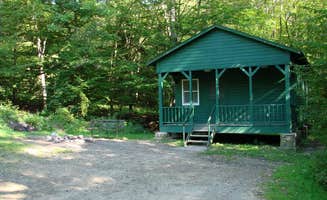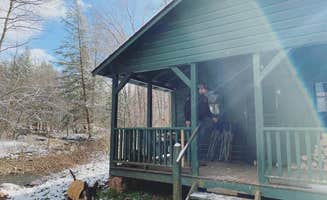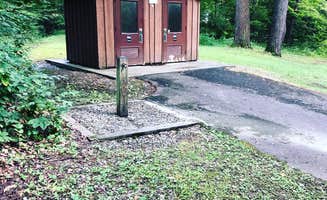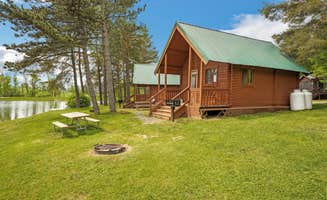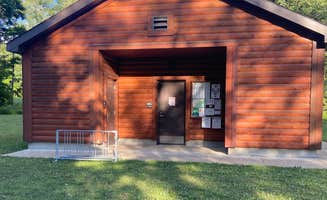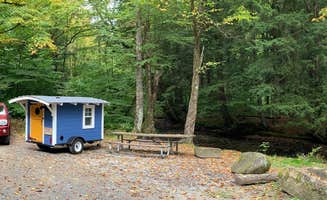Allegany State Park spans over 65,000 acres along the Pennsylvania border, offering diverse cabin and glamping options at elevations between 1,200 and 2,300 feet. The park sits within the Allegheny Highlands, creating a mixed hardwood forest environment with cooler summer temperatures than surrounding lowlands. Most campsites in both the Quaker and Red House areas require advance reservations, especially during peak season.
What to do
Hiking at Thunder Rocks: The Red House Area of Allegany State Park provides access to unique geological formations. "This park is a fun place to hike and explore. Check out Thunder rocks and climb boulders the size of a house," notes Jeremy H. about Red House Area.
Kayaking from campsites: Several waterfront sites at Dewdrop Recreation Area allow direct water access. "We had a nice walk down to the lake itself and we were able to launch our kayaks right from the site," shares Amanda S. about Dewdrop.
Photography in fall: The region offers exceptional fall foliage photography opportunities. "I went here the second week in October 2023 for a fall leaves photography trip. The campground owner is pleasant and available when needed," writes Tracy S. about Red Oak Campground.
Stargazing opportunities: The limited light pollution creates exceptional night sky viewing. "A night sky that you can see the Milky Way and more stars then I remember," according to Denise D. from Dewdrop Recreation Area.
What campers like
Privacy between sites: Many campers appreciate the natural separation between campsites. "The sites are private, flat, surrounded by trees, and have plenty of space," notes Katie from Dewdrop Recreation Area.
Wildlife viewing: The region supports diverse wildlife including black bears. "Wildlife is all around and the area offers a variety of activities within a short drive," shares Denise D. about Dewdrop Recreation Area.
Year-round cabin options: Some cabins remain available throughout winter months. "This place is great for family camping. It has a nice variety of cabins along several loops. Cabins range from rustic to downright homey," writes Mark S. about Red House Area.
Large sites for group camping: Most established campgrounds feature spacious sites. "Campsite layouts are non traditional with large driveways and often times the tables and fire rings are below the driveway. With this layout you get more privacy with very few sites having and overlapping with other sites," explains Travis S. about Dewdrop Recreation Area.
What you should know
Limited cell service: Many campgrounds have minimal or no cellular coverage. "You are literally in the mountains and it is so peaceful! There is no cell service so you really get to be away from all the hustle for a weekend," reports Sarah K. from Dewdrop Recreation Area.
Seasonal pest management: The region occasionally deals with gypsy moth caterpillars. "We booked this campsite in February and we were not told of the Spray block to be used to treat that part of the forest for Gypsy Moth caterpillars that filled our campsite," warns Amanda S. from Dewdrop Recreation Area.
Firewood regulations: Outside firewood may be restricted. "My only complaint the park service asks you not to transport fire wood. We understand why, my problem is when you get to the park the small bundles way over priced 35$ lasted for a night," notes Bobby C. about Quaker Area.
Remote location: The area has limited nearby services. "This area is unique. It's near a small industrial town on the banks of the Alleghany River, where you can find basic dining and stores for convenience," shares Erin H. about Red Oak Campground.
Tips for camping with families
Look for campgrounds with activities: Some campgrounds offer scheduled programming. "This is an awesome place to camp. New improvements to the park have been made the last few years! They run daily activities you can go to and learn about different things in nature," suggests Kelly B. about Red House Area.
Consider sites with playground access: Several campgrounds feature dedicated play areas. "Upon entering the park it was a 20 minute drive to our site. Our site was perfect wooded, gravel pad, water spigot across the street, bear proof box (a first for us)," writes Bobby C. about Quaker Area.
Try glamping for families new to camping: Luxury camping options make outdoor experiences more accessible. "The park has a lot to do in the summer but a group can still have a blast in the winter," explains Alex B. about Quaker Area.
Check campground noise policies: Some locations have varying enforcement of quiet hours. "We enjoyed the hiking trails and the beach with a new modern beach house. There were lots of nature programs put on by the park. The campsites were a little too closely spaced, and no one enforced quiet hours," cautions Kate C. about Quaker Area.
Tips from RVers
Reserve early for hookup sites: Electrical sites are limited at some campgrounds. "Only 3 electric sites so be prepared to be self contained," advises Rebecca E. about Dewdrop Recreation Area.
Bring leveling equipment: Many sites have natural terrain variations. "Pads are gravel and grass. Campground needs general upkeep," notes Chris A. about Red Oak Campground.
Check amperage availability: Power options vary between campgrounds. "Our site only had 30a power. Most seem to be that way. Looks like some updates are on the way. The price was great. We will go back again but making sure it's not peak summer due to not having 50A," advises Nick O. about High Pines RV Park.
Confirm site dimensions: Some campgrounds have varying site sizes. "We had a site in the full hookup back in section, they are very nice spacious sites. The park is close to the Allegheny Reservoir and the Kinzua Bridge," shares Ryan P. about High Pines RV Park.


